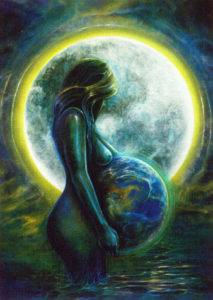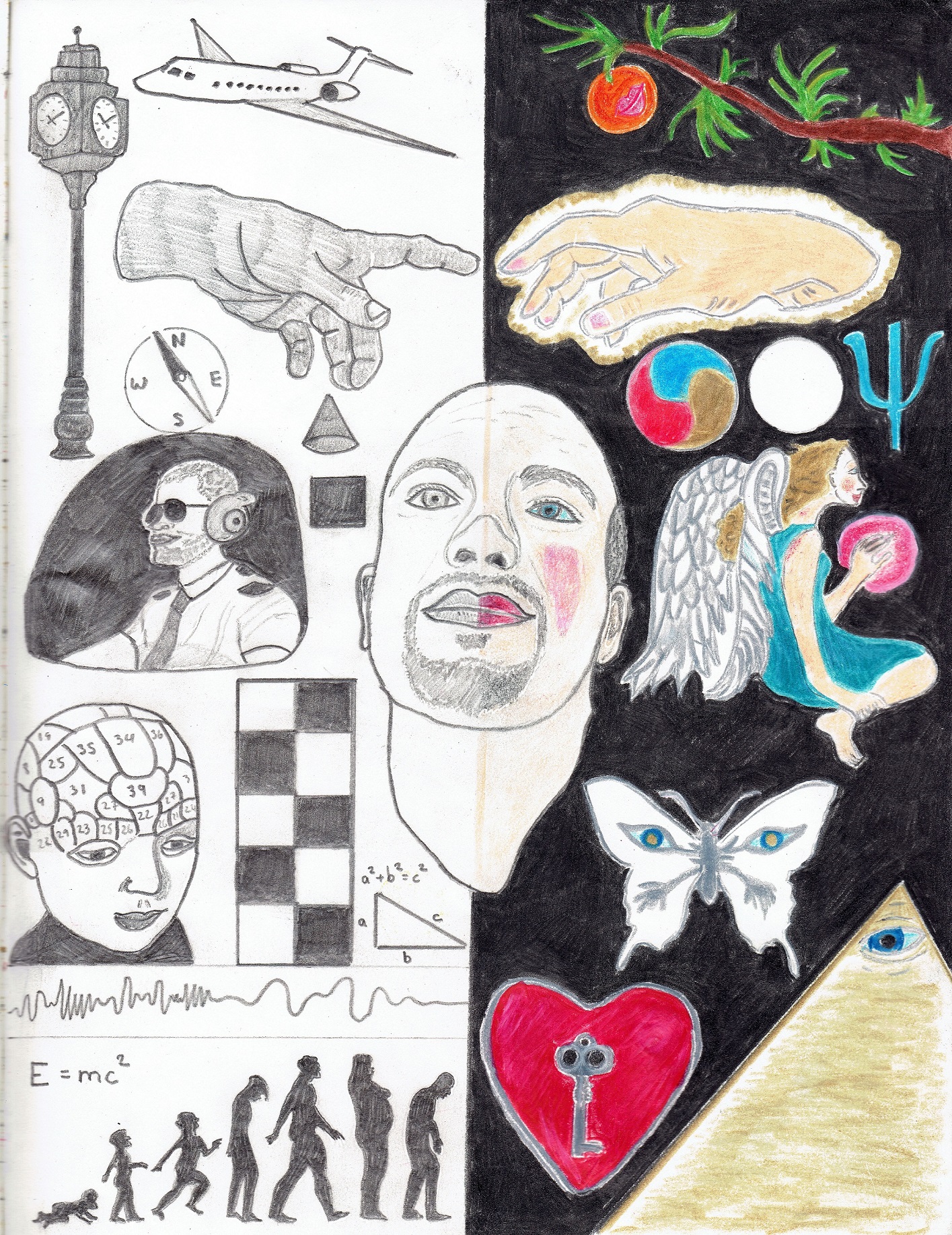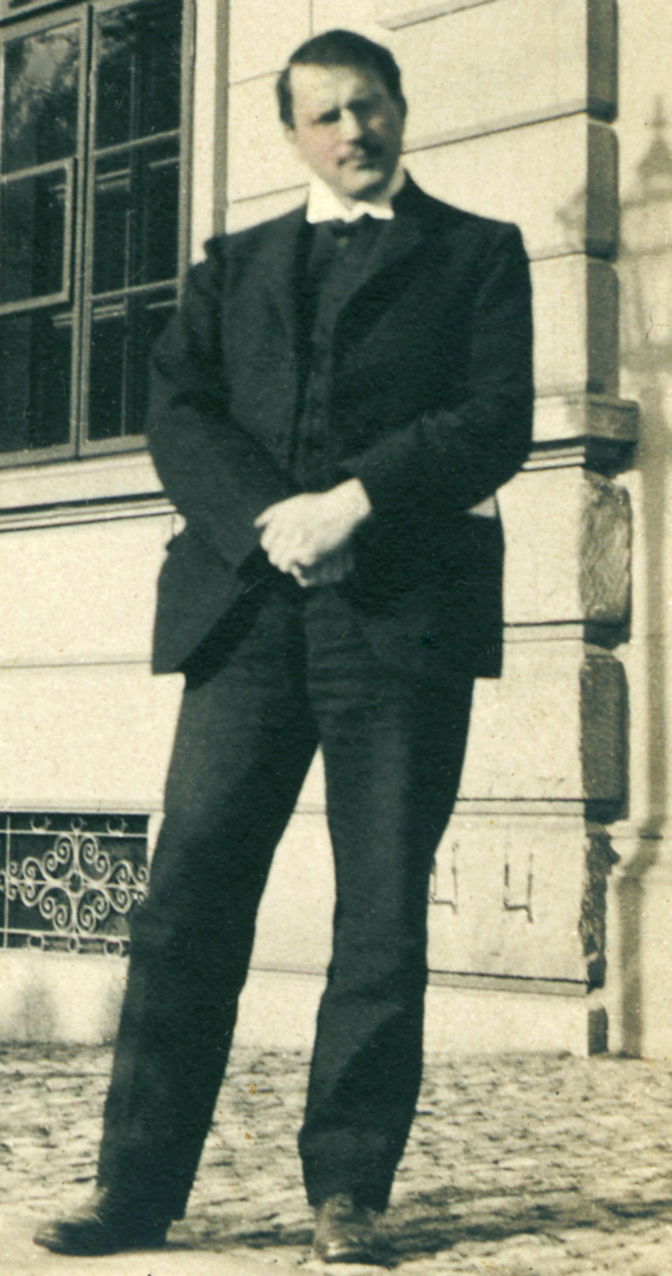
As elucidated in the “Cult of Hathor-Isis and the Mother Archetype” articles, the Great Mother archetype belonging to the sphere of the Divine Feminine is the single most important archetype, or energy-laden image, held in the collective unconscious of humanity. It transcends any barriers that might pertain to culture, gender, race or creed. An encounter with the maternal figure is our first experience of the world, shaping and determining our relationships to others, women, our own bodies, and ultimately the experience of life itself. The experience of this innate archetype occurs during the most impressionable years of our lives, often in early childhood. By analogy alone, we are likely to find the power of the Great Mother archetype accentuated during the Palaeolithic and early Neolithic periods, a time when humanity was still in its early infancy in the context of the origin and history of ego-consciousness. The proliferation and prominence of the primordial feminine consciousness repeats itself at every new revolution of human thought. We are on the cusp of such an occurrence today. My hypothesis, which supports the notion that the powers of the Divine Feminine and in particular the Earth Mother’s Kundalini seeps its way into the conscious awareness of human beings via the mother archetype of the collective unconscious, seeks to elucidate the psychic pathway via which this information is unconsciously propagated to us from the dimension of God-Mind. If one chooses to accept the scientifically flavoured interpretation of conscious evolution that I have suggested in aforementioned “It’s all Greek to me” articles, there are several psychosocial implications that could affect society as a whole and must be considered.
On an anthropological level, it might now be possible to examine the thought processes of individuals whom lived in matriarchal societies of ages bygone; societies which to this day, are poorly understood by archaeology due to the lack of artefacts. These societies would include any groups living during the Palaeolithic or Neolithic period, Predynastic Egypt, Minoan Crete and any early Bronze Age civilization. Through our law of correspondences, we have equated the primordial origin of consciousness with the first years of a child’s life. By applying the nature of the relationship between the mother and the unravelling ego-consciousness of a child to collective human history as a whole, it is possible to attain some insight into the nature of matriarchal culture.
Children spend the majority of their time living out the inner life of their unconscious mind. Some do it consciously and others unconsciously. The faculties of abstract intelligence, science, mathematics, logical reasoning and language begin as seeds containing image-symbols in the child’s subconscious and sprout into consciousness from there. The seat of this inner life is dream, prayer, vision, ritual and imagination. Passive fantasies and visionary experiences (meditation) can also be attributed to it. During his lifetime, Carl Jung observed that the Australian aborigines spent two-thirds of their waking hours doing some form of inner work, just like children; they conducted religious ceremonies, discussed and interpreted their dreams, made spirit quests and ‘went walk about’. It is highly probable that the level of conscious evolution that our own matriarchal ancestors had attained was somewhat similar, if not identical, to that of the aboriginal people on both an exoteric and esoteric level. By studying their traditions and customs, so much can be learnt about our own glorious past. The only considerable difference that I can discern between the two is that the matriarchal societies of early Bronze Age civilization didn’t stop at just visualizing the archetypal forms that appeared in their active imaginations. They actually built them! The architectural feats of early societies, including the Egyptian pyramids at Giza and the labyrinthine Minoan palaces at Knossos, are a testament to the power and influence of the collective unconscious on humanity.
On a more cultural level, professionals in the field of metaphysical inquiry could use the same Jungian model that I have used in critically analysing the role of the Great Mother archetype in early Western civilization to predict the evolutionary course of cosmic consciousness and the kernel of the Divine Feminine in the near future. We know that Pure Mind contains within itself both the polarities of male and female consciousness. Masculine consciousness is associated with the qualities of hard, unyielding, dominating, straight, bright and fiery; the feminine is linked with pliancy, yielding, darkness, moisture and water. The former tends to be exclusive, territorial, dissecting, and hierarchical, implying compartmentalization and subdivision, whilst the latter is accommodating and holistic, implying knowledge of oneness and interconnectedness. During the last few thousand years, alpha male archetypes of the collective unconscious have come to the forefront. These masculine aesthetic types have reared their ugly heads in many staunch leaders–Alexander the Great, Julius Caesar, Genghis Khan, Napoleon Bonaparte, Hitler–all of whom thought that domination “was divine, so to pursue it was noble, heroic and glorious”. The material to be dominated was essentially nature. Begging to differ, the matriarchal cultures of Predynastic Egypt and Minoan Crete considered transcendence illusory and factitious, and the pursuit of power a fatally doomed enterprise seeing as it could never be satisfied, and usually or always involved the destruction of vital qualities and even life itself. Their motto was that domination was not divine but lethal to both dominator and dominated. This makes so much sense. Authority harms the dominator by severing him/her off from trust and mutuality, the foundations of primal love and friendship. Alternatively, it harms the dominated by forcing them into dependency, which precludes truth in all relationships. Domination creates false forms of friendship (society) and love (conventional marriage), masking power relations between the two. Already, we can see the advantages when consciousness is permeated by the Divine Feminine and its archetypes rather than the Divine Masculine.
Now that the twenty-first century has arrived, the sphere of influence of the Great Mother archetype of the Divine Feminine is again beginning to proliferate from its locus of power in the South American mountains. People have begun to grow weary of holier-than-thou personas in fundamentalist religions, businesses and economics either justifying or condoning attitudes that encourage repression, war, uneven distribution of wealth and discrimination against minorities. Patriarchal domination, capitalist fascism or oppression, disaster exploitation and the threat of environmental disaster have the masses yearning for change and a fresher, innovative approach to life. In the coming years, the life-giving Great Mother archetype which has paraded in the guise of Hathor-Isis, Ishtar, Artemis, Sophia and Mary, will again emerge into our collective consciousness, albeit in an original, contemporary form. The “meek will inherit the earth”, so to speak. In this instance, meek denotes a collective global coalition for humanity, with one’s responsibilities as a member of society directed towards the wellbeing of others and an indifference to the enterprise of monetary gain and profit. This brave new world will declare women and children the focus of society, the breakdown of gender roles will become apparent and sexual preferences will no longer be taboo. Education and healthcare would be mandatory; capitalism, on the other hand, would be reviewed and modified. Women would come to the forefront as leaders in politics, religion and commerce, and address global issues such as poverty, injustice, violence, genocide, inequality and war. Partnership, reciprocity and right action would be politically correct and survival-of-the-fittest ideologies shunned. The tax revenue would not be used by the ruling government to fund research into biological and nuclear weapons; it would be put into hospitals and schools, thus increasing the quality and value of life instead. The core ideals of ancient matriarchal societies–obliterating hierarchy, striving for partnership and perfecting harmony with nature–would take their rightful place as the three pillars of a New World centred on the Divine Feminine.
On a psychic level, the Great Mother archetype of the Divine Feminine can appear metaphysically in the dreams and visions of individuals, and it is important for Jungian psychologists and analysts to have a definitive understanding of this powerful archetype before they attempt to do any sort of metaphysical counselling or hypnosis in a clinical setting. The archetype can appear as an old woman, young woman or any talking animal of the female gender, especially a snake, lioness or cow. The kernel of the Great Mother archetype (Hathor-Isis in the Western world) was the consciousness of being the seat of life; a woman’s awareness of her own function of beginner, nurturer and medium for life to accomplish its means. The uroboric Great Mother is also a symbol of the primordial return to infancy for both an individual and to humanity as a while, to a state of existence in which ego consciousness is only just beginning to establish a system of order and a set of assumptions about reality and the universe. Therefore, an encounter with this archetype in a dream or vision should be interpreted as an encounter with the universal energy of maternity that is challenging and affecting one. This might be an indicator that the dreamer unconsciously feels insecure, unloved and unwanted, or that he/she yearns for a nurturer and wishes to be relieved of all their burdening responsibilities in life. Alternatively, an encounter with the Great Mother might also herald a change of some sort, seeing as a return to any beginning carries with it strong overtones of rebirth and reincarnation. It could also signify nostalgia for a return to the distant past or that an aspect of childhood is inextricably linked with a dilemma or issue that has emerged quite recently.
In the following passage, I retell a personal dream of mine in which I experienced the power and mystery of the Great Mother archetype.
I’ve awoken on a shore
I can’t remember how I’ve gotten here
I can’t even remember who I am
I am so frightened and cold
I’m trying to choke back tears
Anger permeates earth and sky
I can feel something in the air
No! I think its coming from the water
The sea is turning into gelatin
Oh! I can see a shape emerging
I’m frightened
I feel like I’ve been punched
It looks like a woman
A woman rising out of the sea
My god she’s all black
I can’t see who she is
Her face is covered by a veil
She’s spotted me
She’s walking toward me
She looks like she’s floating
I can’t move my eyes from her
I’m enchanted
I have this strange intuition
That she knows me
She’s feeling my pain
I’m about to scream
Her arm touches my shoulder
I’m suddenly calm
I can feel warmth
I feel like I’m home
I’m no longer afraid
Her other hand holds a blue lotus
I’ve never seen anything so beautiful
It’s not of this world
She’s not of this world
I can’t see her hand holding the lotus
It seems to be growing out of her
Who are you?
I am the North of your ascendance
I am the South of your demise
I am the East whom gave you birth
I am the West to where you’ll come
Where are you from?
I live in an ocean trench where
Everything has already lived and died
What’s your name?
I am Unknown
Am I dead?
You’re closer to me than you’ll ever be
Why won’t you let me see your face?
I am so old that I would never be recognized
I promise I won’t tell anyone what I saw
Knowledge is power
How does your face look then?
Nothing like what you’ve imagined it
Why are you answering in riddles?
It’s the only way I know how
Why is your skin black?
You’re light and can be seen
I am dark and remain unseen
Do you know me?
I know everybody but nobody knows me
Your voice is inaudible yet I still hear you
Silence is eternal
Who are you?
In time
The lotus is glowing
The light feels so familiar
She presses it to my nose
And the aroma of anamnesis
Rushes through me
The sky screams my name
A schism occurs
And I awaken
Sweating but unafraid
In all dreams and myths, and in this personal encounter with the Great Mother, the conscious mind is symbolized by an island. Like an islander on some remote and little known real estate in the Pacific, my ego had set up a little realm of its own–a world or system of order that was built upon the foundations of personal beliefs, ideals and values amassed over the course of my life. (At that particular time I was about twenty-six years of age.) Of course, our egos are not aware that outside the narrow perimeter of their vision lies the vast sea and accompanying depths of the unconscious mind, in which alternative realities and other truths remain both unexplored and incomprehensible. In my dream, the female figure was unmistakably the Creatrix of the universe, the Great Mother personified, for rising from the unconscious depths her presence was not only reassuring but resonated a warmth that could only be felt by an infant being cuddled by its mother. The presence of the veil and lotus, both sacred to the primordial goddess Hathor-Isis, and the symbolic exchange between the disembodied entity and myself, further verifies the connection. The concluding section of the dream where the Great Mother drew up the lotus to my nose that I may sniff it is potently reminiscent of the Immaculate Conception in the ancient lore of both Egypt and contemporary Christianity. I took this as a sign that something would enter my conscious awareness at some point in the near future and either improve an already well-established worldview or light the way to greater personal discovery.








